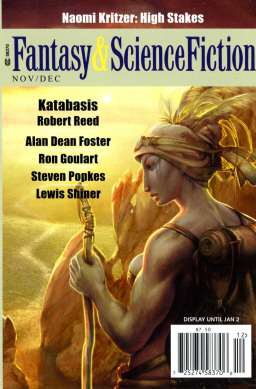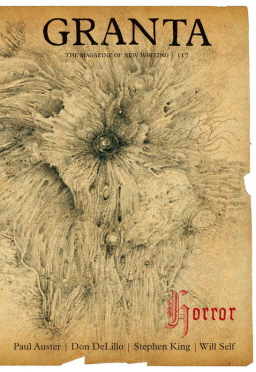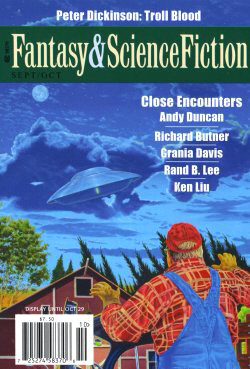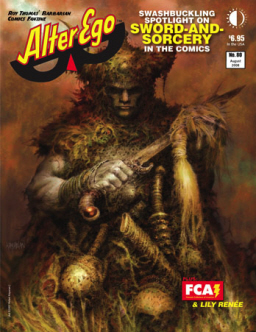November/December Fantasy & Science Fiction Magazine now on Sale
 Cory and Catska Ench provide the intriguing cover to the Nov/Dec cover of Fantasy & Science Fiction, on sale this week. Lois Tilton reviews Robert Reed’s cover novella, “Katabasis,” set in his posthuman “Great Ship” universe, at Locus Online:
Cory and Catska Ench provide the intriguing cover to the Nov/Dec cover of Fantasy & Science Fiction, on sale this week. Lois Tilton reviews Robert Reed’s cover novella, “Katabasis,” set in his posthuman “Great Ship” universe, at Locus Online:
Inside the vast body of the ship, high-gravity beings once built a wheel-shaped habitat that is now used by tourists as a test of endurance. The high-gravity environment is so arduous that beings like humans can hardly bear their own weight, so they must employ porters to carry their food and water – and their bodies if they fail during the attempt. Katabasis works as a porter; she is a survivor of the arduous journey her own people once took to reach the ship…
The Great Ship is essentially a stage where different adventures can be set… knowledge of the previous stories is by no means required to enjoy the present one. What makes it different from other stages is time. The voyage is near-infinite in duration. Lifespans are measured in millennia. And as the author reminds us, death in this universe is no longer a permanent consideration. Xenophon was a student of Socrates, who would say that all humans are mortal. Reed makes us ask what, then, are the passengers on the Great Ship?
–RECOMMENDED
 Yearly subscriptions are available through the Apex website and Weightless Books. For $17.95, $2.00 off the normal subscription rate, you can have 12 months of Apex Magazine delivered to you in the file format of your choice: ePub, mobi, or PDF. That’s at least 24 brand new short stories dropped into your eager little hands for the price of an anthology. Plus, you get the reprints, poetry, nonfiction and interviews. Quite a deal, right?
Yearly subscriptions are available through the Apex website and Weightless Books. For $17.95, $2.00 off the normal subscription rate, you can have 12 months of Apex Magazine delivered to you in the file format of your choice: ePub, mobi, or PDF. That’s at least 24 brand new short stories dropped into your eager little hands for the price of an anthology. Plus, you get the reprints, poetry, nonfiction and interviews. Quite a deal, right?




 Andy Duncan gets the cover this issue for “Close Encounters,” a rural tale of alien abduction. Here’s what Lois Tilton says about it in her review at
Andy Duncan gets the cover this issue for “Close Encounters,” a rural tale of alien abduction. Here’s what Lois Tilton says about it in her review at 

